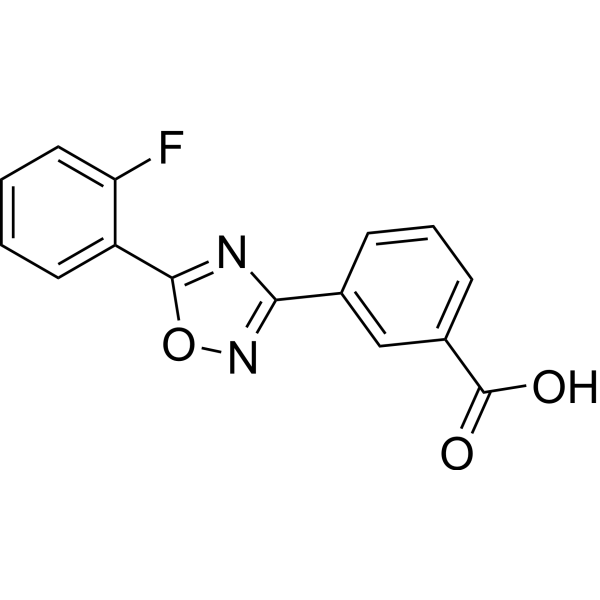Home
Products
Ataluren (PTC124)



| Product Name | Ataluren (PTC124) |
| Price: | Inquiry |
| Catalog No.: | CN00361 |
| CAS No.: | 775304-57-9 |
| Molecular Formula: | C15H9FN2O3 |
| Molecular Weight: | 284.24 g/mol |
| Purity: | >=98% |
| Type of Compound: | Alkaloids |
| Physical Desc.: | Powder |
| Source: | |
| Solvent: | Chloroform, Dichloromethane, Ethyl Acetate, DMSO, Acetone, etc. |
| SMILES: | Fc1ccccc1c1onc(n1)c1cccc(c1)C(=O)O |
| Contact us | |
|---|---|
| First Name: | |
| Last Name: | |
| E-mail: | |
| Question: | |
| Description | Ataluren (PTC124) is an orally available CFTR-G542X nonsense allele inhibitor. |
| Target | CFTR[1] |
| In Vitro | This premature “stop” signal (a class I mutation) prevents the cell from producing a full-length CFTR protein[1]. Ataluren (PTC124)-a new chemical entity that selectively induces ribosomal readthrough of premature but not normal termination codons[2]. |
| In Vivo | Ataluren (PTC124) activity, optimized using nonsense-containing reporters, promotes dystrophin production in primary muscle cells from humans and mdx mice expressing dystrophin nonsense alleles, and rescues striated muscle function in mdx mice within 2-8 weeks of drug exposure. Ataluren (PTC124) is well tolerated in animals at plasma exposures substantially in excess of those required for nonsense suppression[2]. To induce nonsense suppression and increase PPT1 enzyme activity, the read-through drug Ataluren (PTC124) is given via intraperitoneal (i.p.) injection to male Cln1R151X mice at 2 months of age. These treatments are performed four times daily for 2 consecutive days in a proof-of-principle study. Used at 10 mg/kg, Ataluren (PTC124) increased PPT1 enzyme activity (P=0.0001 by unpaired t-test) and protein level (P=0.0014 by unpaired t-test) in the liver, but did not increase PPT1 enzyme activity or protein level in the cortex. This tissue-specific effect is likely due to the inability of Ataluren (PTC124) to breach the blood brain barrier (BBB), which decreased the bioavailability of Ataluren (PTC124) within the brain, and prevented Ataluren (PTC124) from reaching an efficacious concentration within the therapeutic window[3]. |
| Cell Assay | Duplicate samples of HEK293 cells harbouring LUC-190 (UGA) are incubated in the presence of 5 μM Ataluren (PTC124) (treated) or 1% DMSO (untreated) for 20 h. The cells are collected, washed twice in phosphate buffered saline (PBS), resuspended in sample buffer (Bio-Rad) and shipped on dry ice to Kendrick Laboratories for two-dimensional electrophoretic analysis Isoelectric focusing (pH 3.5-10) is carried out in glass tubes for 20,000 V-hours. One μg of a tropomyosin internal standard is added to each sample. Second dimension SDS slab gel electrophoresis is carried out for approximately 6 h at 25 mA per gel. After electrophoresis, gels are transferred to PVDF paper. Computerized analysis of spot mobility used Phoretix software[2]. |
| Animal Admin | Mice[3] Male mice are randomly assigned to either a treatment group or vehicle control group. Six to eight mice per group are treated with 10 or 100 mg/kg Ataluren (PTC124) dissolved in PBS containing DMSO (2% for 10 mg/kg and 20% for 100 mg/kg) and (2-hydroxypropyl)-β-cyclodextrin (22%) via intraperitoneal (i.p.) injections four times daily for 2 consecutive days. Six to eight control mice are treated with the vehicle of the drug: PBS containing DMSO (2% or 20%) and (2-hydroxypropyl)-β-cyclodextrin (22%). Immediately following the last injection on the second day, tissues are collected and stored at −80°C for further use. |
| Density | 1.4±0.1 g/cm3 |
| Boiling Point | 503.7±60.0 °C at 760 mmHg |
| Flash Point | 258.4±32.9 °C |
| Exact Mass | 284.059723 |
| PSA | 76.22000 |
| LogP | 3.73 |
| Vapour Pressure | 0.0±1.4 mmHg at 25°C |